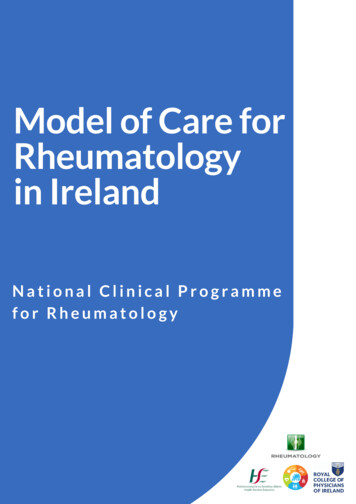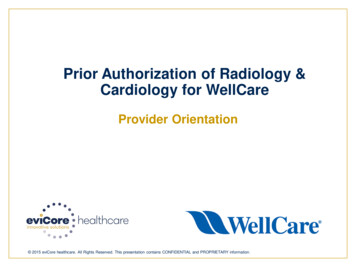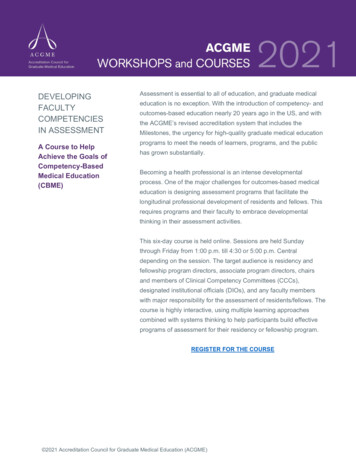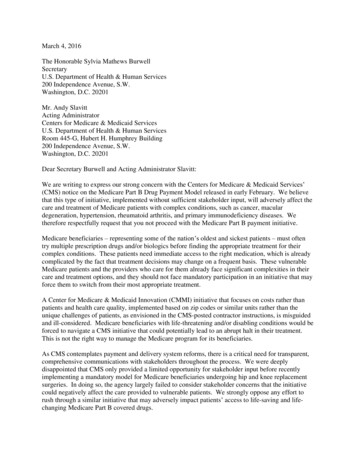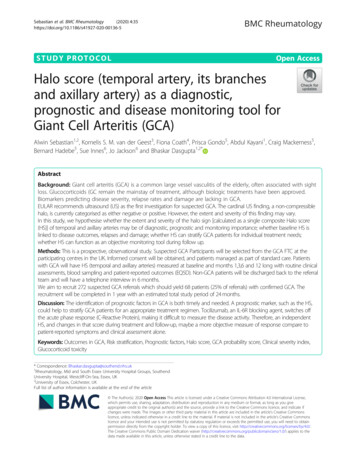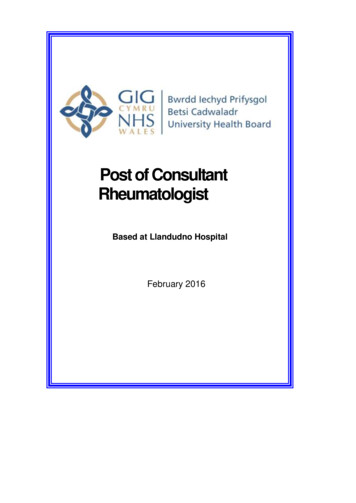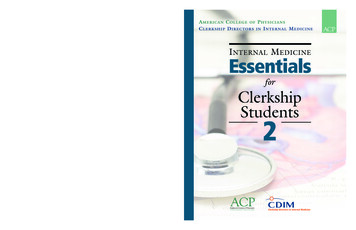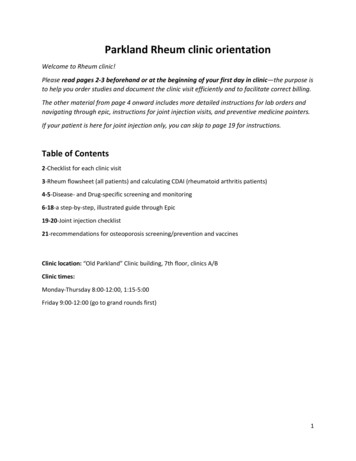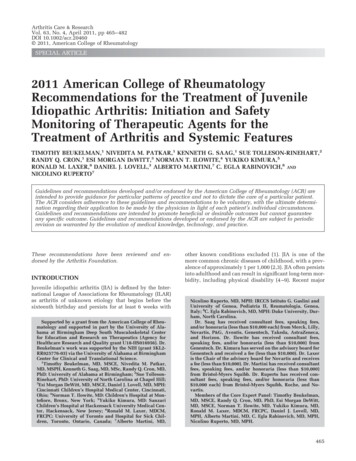
Transcription
Arthritis Care & ResearchVol. 63, No. 4, April 2011, pp 465– 482DOI 10.1002/acr.20460 2011, American College of RheumatologySPECIAL ARTICLE2011 American College of RheumatologyRecommendations for the Treatment of JuvenileIdiopathic Arthritis: Initiation and SafetyMonitoring of Therapeutic Agents for theTreatment of Arthritis and Systemic FeaturesTIMOTHY BEUKELMAN,1 NIVEDITA M. PATKAR,1 KENNETH G. SAAG,1 SUE TOLLESON-RINEHART,2RANDY Q. CRON,1 ESI MORGAN DEWITT,3 NORMAN T. ILOWITE,4 YUKIKO KIMURA,5RONALD M. LAXER,6 DANIEL J. LOVELL,3 ALBERTO MARTINI,7 C. EGLA RABINOVICH,8 ANDNICOLINO RUPERTO7Guidelines and recommendations developed and/or endorsed by the American College of Rheumatology (ACR) areintended to provide guidance for particular patterns of practice and not to dictate the care of a particular patient.The ACR considers adherence to these guidelines and recommendations to be voluntary, with the ultimate determination regarding their application to be made by the physician in light of each patient’s individual circumstances.Guidelines and recommendations are intended to promote beneficial or desirable outcomes but cannot guaranteeany specific outcome. Guidelines and recommendations developed or endorsed by the ACR are subject to periodicrevision as warranted by the evolution of medical knowledge, technology, and practice.These recommendations have been reviewed and endorsed by the Arthritis Foundation.INTRODUCTIONJuvenile idiopathic arthritis (JIA) is defined by the International League of Associations for Rheumatology (ILAR)as arthritis of unknown etiology that begins before thesixteenth birthday and persists for at least 6 weeks withSupported by a grant from the American College of Rheumatology and supported in part by the University of Alabama at Birmingham Deep South Musculoskeletal Centerfor Education and Research on Therapeutics (Agency forHealthcare Research and Quality grant U18-HS016956). Dr.Beukelman’s work was supported by the NIH (grant 5KL2RR025776-03) via the University of Alabama at BirminghamCenter for Clinical and Translational Science.1Timothy Beukelman, MD, MSCE, Nivedita M. Patkar,MD, MSPH, Kenneth G. Saag, MD, MSc, Randy Q. Cron, MD,PhD: University of Alabama at Birmingham; 2Sue TollesonRinehart, PhD: University of North Carolina at Chapel Hill;3Esi Morgan DeWitt, MD, MSCE, Daniel J. Lovell, MD, MPH:Cincinnati Children’s Hospital Medical Center, Cincinnati,Ohio; 4Norman T. Ilowite, MD: Children’s Hospital at Montefiore, Bronx, New York; 5Yukiko Kimura, MD: SanzariChildren’s Hospital at Hackensack University Medical Center, Hackensack, New Jersey; 6Ronald M. Laxer, MDCM,FRCPC: University of Toronto and Hospital for Sick Children, Toronto, Ontario, Canada; 7Alberto Martini, MD,other known conditions excluded (1). JIA is one of themore common chronic diseases of childhood, with a prevalence of approximately 1 per 1,000 (2,3). JIA often persistsinto adulthood and can result in significant long-term morbidity, including physical disability (4 –9). Recent majorNicolino Ruperto, MD, MPH: IRCCS Istituto G. Gaslini andUniversity of Genoa, Pediatria II, Reumatologia, Genoa,Italy; 8C. Egla Rabinovich, MD, MPH: Duke University, Durham, North Carolina.Dr. Saag has received consultant fees, speaking fees,and/or honoraria (less than 10,000 each) from Merck, Lilly,Novartis, P&G, Aventis, Genentech, Takeda, AstraZeneca,and Horizon. Dr. Ilowite has received consultant fees,speaking fees, and/or honoraria (less than 10,000) fromGenentech. Dr. Kimura has served on the advisory board forGenentech and received a fee (less than 10,000). Dr. Laxeris the Chair of the advisory board for Novartis and receivesa fee (less than 10,000). Dr. Martini has received consultantfees, speaking fees, and/or honoraria (less than 10,000)from Bristol-Myers Squibb. Dr. Ruperto has received consultant fees, speaking fees, and/or honoraria (less than 10,000 each) from Bristol-Myers Squibb, Roche, and Novartis.Members of the Core Expert Panel: Timothy Beukelman,MD, MSCE, Randy Q. Cron, MD, PhD, Esi Morgan DeWitt,MD, MSCE, Norman T. Ilowite, MD, Yukiko Kimura, MD,Ronald M. Laxer, MDCM, FRCPC, Daniel J. Lovell, MD,MPH, Alberto Martini, MD, C. Egla Rabinovich, MD, MPH,Nicolino Ruperto, MD, MPH.465
466Beukelman et aladvances in treatment have greatly improved short- andmedium-term outcomes for children with JIA (10 –17), yetno validated guidelines offer recommendations for thetreatment of JIA.To develop recommendations for the safest and mosteffective treatment of JIA on behalf of the American College of Rheumatology (ACR), we applied the establishedResearch and Development/University of California at LosAngeles (RAND/UCLA) Appropriateness Method (18) toderive recommendations that are as evidence based aspossible. Similar methods were used recently in the development of the ACR recommendations for the use ofdisease-modifying antirheumatic drugs (DMARDs) forrheumatoid arthritis (19) and the management of glucocorticoid-induced osteoporosis (20). We sought to give ourrecommendations additional strength by following theprinciples of the Appraisal of Guidelines for Research andEvaluation instrument (21), a framework designed specifically to assess the quality of clinical practice guidelines,including the methods used for their development and thecontent of the final recommendations.Our effort focused on the initiation and safety monitoring of therapeutic agents in the treatment of JIA, includingnonsteroidal antiinflammatory drugs (NSAIDs), intraarticular glucocorticoid injections, nonbiologic DMARDs, biologic DMARDs, and systemic glucocorticoids for the treatment of the systemic features of systemic arthritis. Theindications for systemic glucocorticoids for the treatmentof synovitis were not considered, owing to a lack of published evidence. We did not consider all ILAR categoriesof JIA individually and instead grouped children with JIAinto distinct “treatment groups” (see Materials and Methods). We did not consider the economic costs of JIA or itstreatment for two reasons: first, too few economic analysesof JIA exist to permit conclusions; second, the RAND/UCLA Appropriateness Method specifically does not consider cost implications (18). These recommendations weredeveloped with international input and are intended toinform and benefit health care providers caring for children with JIA throughout the world. Many recommendations fall outside the present bounds of regulatory agency–approved labeling, but reflect common and widelyaccepted practices in the field.The products of this project are termed “recommendations” rather than guidelines in order to reflect their nonprescriptive nature. They are meant to function as a reference and do not serve as a substitute for individualizedpatient assessment and clinical decision making, especially when conducted by specialist clinicians familiarwith the treatment of JIA. Importantly, these recommendations are not intended to limit health care coverage forchildren with JIA.Members of the Task Force Panel: Suzanne L. Bowyer, MD(Indiana University School of Medicine, Indianapolis),Pavla Dolezalova, MD, PhD (Charles University, Prague,Czech Republic), Ciaran M. Duffy, MBBCh, MSc (McGillUniversity, Montreal, Quebec, Canada), James P. Guevara,MD, MPH (Children’s Hospital of Philadelphia, Philadelphia, PA), Anne Murphy, PhD (University of California, SanDiego), Murray H. Passo, MD (Medical University of SouthCarolina, Charleston), Marilynn Punaro, MD (University ofTexas Southwestern, Dallas), Rayfel Schneider, MBBCh,FRCPC (University of Toronto and Hospital for Sick Children, Toronto, Ontario, Canada), David D. Sherry, MD (Children’s Hospital of Philadelphia, Philadelphia, PA), Earl D.Silverman, MD, FRCPC (University of Toronto and Hospitalfor Sick Children, Toronto, Ontario, Canada), Janalee Taylor, RN, MSN, CPNP (Cincinnati Children’s Hospital Medical Center, Cincinnati, OH), Carol A. Wallace, MD (SeattleChildren’s Hospital Medical Center, Seattle, WA).Members of the University of Alabama at BirminghamWorking Group: Sheree Carter, RN, MSN, Jeffrey R. Curtis,MD, MPH, Archana Jain, MD, Amy Mudano, MPH, Pongthorn Narongroeknawin, MD.Members of the University of North Carolina at ChapelHill Working Group: Rachel Fesperman, MD, MPH, BethanyKoestner, MSLS, Lynne Morris, MLS, Karen Rusak, MD,MPH.American College of Rheumatology Board of DirectorsLiaison: Raphael Hirsch, MD (University of Pittsburgh, Pittsburgh, PA).The American College of Rheumatology is an independentprofessional, medical, and scientific society which does notguarantee, warrant, or endorse any commercial product orservice.Address correspondence to Timothy Beukelman, MD,MSCE, Pediatric Rheumatology, University of Alabama atBirmingham, 1600 7th Avenue South CPP 210, Birmingham,AL 35233-1711. E-mail: tbeukelman@peds.uab.edu.Submitted for publication June 29, 2010; accepted in revised form December 6, 2010.RAND/UCLA Appropriateness Method overview. TheRAND/UCLA Appropriateness Method was originally developed to help determine when the benefits of a medicalintervention outweigh the risks (18) with the understanding that the published literature often does not provideevidence at the level of detail required to guide decisionsin everyday clinical practice. This method relies upon theefforts of two distinct groups of participants: the CoreExpert Panel (CEP) and the Task Force Panel (TFP). OurCEP was composed of experienced pediatric rheumatologists from the US, Canada, and Europe who are among theworld’s leaders in the investigation of the treatment of JIA.The TFP contained internationally recognized pediatricrheumatology clinicians and researchers from the US, Canada, and Europe; an advanced practice pediatric rheumatology nurse; a general pediatrician with expertise in evidence-based medicine; and a patient representative, i.e., aparent of a child with JIA who has broad experience in JIAand family treatment preferences.The initial step was a systematic review of the literature,which was then used by the CEP to prepare a summaryreport of the latest scientific evidence. Concurrently, theCEP prepared a comprehensive list of clinical scenarios (orpotential indications) for each medical intervention of interest to be addressed by the recommendations. The scenarios categorized hypothetical patients using all possiblecombinations of key clinical parameters, such as diseaseactivity and prognostic features, relevant to the decisionprocess. The evidence report and the clinical scenarioswere presented to the TFP for their review.Evaluation of the scenarios by the TFP led directly to therecommendations for each medical intervention. In thefirst round of voting, the TFP anonymously and indepen-MATERIALS AND METHODS
ACR 2011 Recommendations for the Treatment of JIAdently rated the appropriateness of the medical interventions in the clinical scenarios based on the scientific evidence and their best clinical judgment. Differences inopinion from the first round of voting were discussed at aface-to-face meeting, followed by a second rating of theclinical scenarios. The final ratings were compiled andassessed by the CEP and no significant discrepancies wereidentified. Finally, the ratings were used by the CEP tocreate recommendations from the clinical scenarios.Scope of recommendations. These recommendationscover the indications and safety monitoring for the use ofNSAIDs, intraarticular glucocorticoid injections, nonbiologic DMARDs, biologic DMARDs, and systemic glucocorticoids for the treatment of the systemic features of systemic arthritis. In contrast to prior ACR recommendations,the scope of this project was not explicitly established bythe ACR, but rather by the CEP members. An exhaustivelist of broad potential topics for inclusion was constructedby the principal investigator (TB) and reviewed and revised by 3 other authors (RQC, EMD, KGS). The resultantlist of 23 potential topics for consideration was distributedto all CEP members. Using a modified Delphi process viaelectronic mail, the list of topics was prioritized and gradually shortened until it was deemed feasible in the timeallotted to the project. As a result, several relevant topicswere necessarily omitted. Medication contraindicationsand intolerance were not considered. We suggest referringto the 2008 ACR recommendations for the use of DMARDsin rheumatoid arthritis (19) for general guidance aboutmedication contraindications. Tapering or discontinuation of medications for patients with inactive disease wasalso not considered. Only the most relevant and frequentlyused agents within each medication class were included,as determined using a structured iterative process via electronic mail with repeated revisions to the proposed listuntil it was accepted by all CEP members. Agents notwidely commercially available for the treatment of JIA atthe time of the literature search (e.g., canakinumab, rilonacept, tocilizumab) were excluded. The indications for systemic glucocorticoids for the treatment of synovitis werenot considered, owing to a lack of published evidence. Thetreatment of uveitis, enthesitis, and macrophage activationsyndrome was not considered.Systematic literature review. The systematic literaturereview was restricted to publications available in Medline.Briefly, we searched using PubMed for articles in English,with abstracts, and published from 1966 to the present.The final search strategy, developed in consultation with avirtual reference librarian, is shown in SupplementaryAppendix A (available in the online version of this articleat SN)2151-4658). We performed the final search on March 3,2009, and identified 756 articles for further consideration.We next performed title and abstract review of the identified articles. In keeping with the scope of the recommendations, all studies that did not explicitly address anypharmacotherapeutic clinical outcomes of the medicationsof interest were excluded (e.g., radiographic descriptivestudies, pharmacokinetics, genomics, etc.). Because of the467relatively small number of identified articles, we includeduncontrolled studies, regardless of the number of patientsreported. Review articles were excluded. Two reviewersreviewed all of the abstracts for inclusion, blinded to eachother’s determinations. Disagreement was resolved by athird reviewer (ST-R) and confirmed by a fourth reviewer(TB), when necessary. Following title and abstract review,239 articles remained for consideration.Each of the full-length articles was abstracted by one of ateam of reviewers with key elements from each articleentered into an electronic database. Articles were excluded during the full-length article review when no pharmacotherapeutic clinical outcomes of medications of interest were identified; all of these exclusions were verifiedby a second reviewer (TB). As a result, 214 articles wereincluded in the final comprehensive evidence report thatwas presented to the TFP prior to the first round of voting.An identical literature search was repeated on October5, 2009, to identify any new publications since the firstsystematic review. Thirty new articles were identified andsubjected to the same review process as the initial search.Seven fully abstracted articles were added to the updatedevidence report and presented to the TFP prior to theface-to-face meeting.Scenario definitions. In order to develop clinical scenarios in accordance with the RAND/UCLA Appropriateness Method (18), several key clinical decision parameterswere deemed necessary by the CEP: disease phenotype,prognostic features, disease activity, and current therapy.Definitions and values for these key parameters were asevidence based as possible and were determined using astructured iterative process via electronic mail with repeated revisions to the proposed parameters until theywere accepted by all CEP members.JIA treatment groups. Chronic childhood arthritis is aheterogeneous condition. The most recent ILAR diseaseclassification criteria (1) divide JIA into 6 distinct categories. However, this disease classification system was notstrictly applied to the development of these recommendations for two reasons: currently, there is minimal evidenceto support the differential treatment of children with JIAfor many of the category distinctions, and the inclusion ofall 6 categories would unnecessarily increase the totalnumber of scenarios to an unmanageable number for consideration by the TFP (18).In place of the ILAR JIA classification, the CEP developed “treatment groups” for these recommendations withthe goal of succinctly representing clinical decision making in the treatment of JIA. The JIA category of systemicarthritis proved to be especially challenging to evaluate.Attempts to exhaustively depict the myriad possible clinical presentations of systemic arthritis were impractical.Therefore, recommendations for the treatment of significant active systemic features (e.g., fever) and active arthritis for patients with systemic arthritis were consideredseparately and independently by the TFP. Other authorshave suggested this dichotomy when considering therapeutic choices for systemic arthritis (22). The appropriatetreatment of systemic arthritis patients with concurrently
468Beukelman et alTable 1. Features of poor prognosis and disease activityfor a history of arthritis of 4 or fewer jointsFEATURES OF POOR PROGNOSIS (must satisfy 1)Arthritis of the hip (23–25) or cervical spineArthritis of the ankle (25–27) or wrist (26,28) ANDmarked (29) or prolonged (23,25,26,29,30)inflammatory marker elevationRadiographic damage (erosions or joint spacenarrowing by radiograph) (31)DISEASE ACTIVITY LEVELSLow disease activity (must satisfy all)1 or fewer active jointsErythrocyte sedimentation rate or C-reactive proteinlevel normalPhysician global assessment of overall diseaseactivity 3 of 10Patient/parent global assessment of overall well-being 2 of 10Moderate disease activity (does not satisfy criteriafor low or high activity)1 or more features greater than low disease activitylevel AND fewer than 3 features of high diseaseactivityHigh disease activity (must satisfy at least 3)2 or more active jointsErythrocyte sedimentation rate or C-reactive proteinlevel greater than twice upper limit of normalPhysician global assessment of overall diseaseactivity ⱖ7 of 10Patient/parent global assessment of overall well-beingⱖ4 of 10active systemic features and active arthritis may be expected to incorporate elements of both sets of recommendations, but this was not explicitly considered by the TFP.The 5 JIA treatment groups used in these recommendations are described below.History of arthritis of 4 or fewer joints. This group includes patients with the ILAR categories of persistent oligoarthritis, as well as patients with psoriatic arthritis, enthesitis-related arthritis, and undifferentiated arthritiswho have developed active arthritis in only 4 or fewerjoints in total throughout the history of their diseasecourse. Patients who currently have 4 or fewer activejoints, but who have a history of 5 or more active joints intotal, are considered in the “history of arthritis of 5 or morejoints” treatment group. Patients with systemic arthritis oractive sacroiliac arthritis are considered in separate treatment groups.History of arthritis of 5 or more joints. This group includes patients with the ILAR categories of extended oligoarthritis, rheumatoid factor (RF)–negative polyarthritis,RF-positive polyarthritis, as well as patients with psoriaticarthritis, enthesitis-related arthritis, and undifferentiatedarthritis who have developed active arthritis in 5 or morejoints in total throughout the history of their disease. Patients in this group need not currently have 5 or moreactive joints. Patients with systemic arthritis or active sacroiliac arthritis are considered in separate treatment groups.Active sacroiliac arthritis. This group includes all patients with clinical and imaging evidence of active sacro-iliac arthritis. This group is anticipated to include primarily patients with the ILAR categories of enthesitis-relatedarthritis and psoriatic arthritis, but may include patientsfrom any of the ILAR JIA categories.Systemic arthritis with active systemic features (andwithout active arthritis). This group includes all patientswho fulfill the ILAR criteria for systemic arthritis and whohave active fever of systemic JIA with or without othersystemic features, but without active arthritis. An exampleof this clinical phenotype would be a patient whose arthritis resolved spontaneously or rapidly upon initiation ofNSAIDs but who had persistent fever.Systemic arthritis with active arthritis (and without active systemic features). This category includes all patientswho fulfill the ILAR criteria for systemic arthritis and whohave active arthritis, but without active systemic features.An example of this clinical phenotype would be a patientwhose systemic features resolved spontaneously or rapidly upon initiation of NSAIDs but whose arthritis remained active.Features of poor prognosis. Risk stratification is crucialfor guiding optimal treatment. The prognosis for patientswith JIA is variable, and some clinical factors have beenshown to predict worse outcomes. The CEP considered thepublished literature and their personal clinical experiencein developing the features of poor prognosis for theserecommendations.Each JIA treatment group has its own respective featuresof poor prognosis. In each case, the presence of one listedTable 2. Features of poor prognosis and disease activityfor a history of arthritis of 5 or more jointsFEATURES OF POOR PROGNOSIS (must satisfy 1)Arthritis of the hip (23–25) or cervical spinePositive rheumatoid factor (5,23,28,30,32,33) OR anti–cyclic citrullinated peptide (33,34) antibodiesRadiographic damage (erosions or joint spacenarrowing by radiograph) (31)DISEASE ACTIVITY LEVELSLow disease activity (must satisfy all)4 or fewer active jointsErythrocyte sedimentation rate or C-reactive proteinlevel normalPhysician global assessment of overall diseaseactivity 4 of 10Patient/parent global assessment of overall well-being 2 of 10Moderate disease activity (does not satisfy criteria forlow or high activity)1 or more features greater than low disease activitylevel AND fewer than 3 features of high diseaseactivityHigh disease activity (must satisfy at least 3)8 or more active jointsErythrocyte sedimentation rate or C-reactive proteinlevel greater than twice upper limit of normalPhysician global assessment of overall diseaseactivity ⱖ7 of 10Patient/parent global assessment of overall well-beingⱖ5 of 10
ACR 2011 Recommendations for the Treatment of JIATable 3. Feature of poor prognosis and disease activityfor active sacroiliac arthritisFEATURE OF POOR PROGNOSISRadiographic damage of any joint (erosions or jointspace narrowing by radiograph)DISEASE ACTIVITY LEVELSLow disease activity (must satisfy all)Normal back flexionErythrocyte sedimentation rate or C-reactive proteinlevel normalPhysician global assessment of overall diseaseactivity 4 of 10Patient/parent global assessment of overall well-being 2 of 10Moderate disease activity (does not satisfy criteria forlow or high activity)1 or more features greater than low disease activitylevel AND fewer than 2 features of high diseaseactivityHigh disease activity (must satisfy at least 2)Erythrocyte sedimentation rate or C-reactive proteingreater than twice upper limit of normalPhysician global assessment of overall diseaseactivity ⱖ7 of 10Patient/parent global assessment of overall well-beingⱖ4 of 10feature is sufficient to classify the patient as having a poorprognosis for the purposes of these recommendations. Amore complex approach to features of poor prognosiswould have increased the number of scenarios to an unmanageable number for consideration by the TFP (18). Thefeatures of poor prognosis (and their corresponding literature references) are listed according to each JIA treatmentgroup in Tables 1–5. Of note, the CEP believed there wasinsufficient published evidence available to include damage detected by imaging other than radiographs as a featureof poor prognosis in JIA.JIA disease activity. Recommendations require cleardefinitions of disease activity to make rational therapeuticchoices. In these recommendations, “active joints” and“active arthritis” are defined by joints with swelling notdue to deformity or joints with limitation of motion andTable 4. Features of poor prognosis and disease activityfor systemic arthritis with active systemic features (andwithout active arthritis)FEATURES OF POOR PROGNOSIS6-month duration of significant active systemic disease,defined by: fever (35–37), elevated inflammatorymarkers (35–37), or requirement for treatment withsystemic glucocorticoids (36)DISEASE ACTIVITY LEVELS (2 levels)Active fever AND physician global assessment ofoverall disease activity 7 of 10Active fever AND systemic features of high diseaseactivity (e.g., significant serositis) that result inphysician global assessment of overall diseaseactivity ⱖ7 of 10469Table 5. Features of poor prognosis and disease activityfor systemic arthritis with active arthritis (and withoutactive systemic features)FEATURES OF POOR PROGNOSIS (must satisfy 1)Arthritis of the hip (38)Radiographic damage (erosions or joint spacenarrowing by radiograph) (31)DISEASE ACTIVITY LEVELSLow disease activity (must satisfy all)4 or fewer active jointsErythrocyte sedimentation rate or C-reactive proteinlevel normalPhysician global assessment of overall diseaseactivity 4 of 10Patient/parent global assessment of overall well-being 2 of 10Moderate disease activity (does not satisfy criteria forlow or high activity)1 or more features greater than low disease activitylevel AND fewer than 3 features of high diseaseactivityHigh disease activity (must satisfy at least 3)8 or more active jointsErythrocyte sedimentation rate or C-reactive proteinlevel greater than twice upper limit of normalPhysician global assessment of overall diseaseactivity ⱖ7 of 10Patient/parent global assessment of overall well-beingⱖ5 of 10with pain or tenderness (10). “Active fever” means currentfever that is attributable to systemic arthritis disease activity. At least one continuous measure of JIA disease activityhas been recently developed (39). Nevertheless, currentlyno continuous disease activity measures have been extensively validated or widely applied to daily clinical practice. Accordingly, the CEP developed levels of diseaseactivity for these recommendations that are specific toeach treatment group and with the goal of succinctly capturing clinical decision making. It should be noted thatthese disease activity levels are subjective and not strictlyevidence based. However, the creation of discrete diseaseactivity levels was requisite for the effective use of theRAND/UCLA Appropriateness Method.These recommendations are based on 3 disease activitylevels: low, moderate, and high. Patients with inactivedisease were not considered. In a broad sense, the lowdisease activity level is meant to represent patients at thelowest disease activity level for which a majority of clinicians may consider altering the current medication regimen, and the high disease activity level is meant to represent patients with disease activity that is equivalent to orhigher than the “average” subject that may have beenenrolled in a clinical trial of the medications under consideration. The CEP considered baseline patient data fromrecently published clinical trials (10,15,17,40 – 42), datafrom a recent attempt to define minimal disease activity inJIA (43), and their personal clinical experience in developing the disease activity levels for these recommendations. The disease activity levels are listed according toeach JIA treatment group in Tables 1–5.
470During the evaluation of the clinical scenarios, TFPmembers were allowed to recommend continuation of current therapy (not initiate a new therapeutic agent), regardless of the current disease activity level. In addition to apatient’s current disease activity level, clinicians in practice may consider a patient’s disease activity level prior toinitiating the current treatment regimen when evaluatingthe effectiveness of the current treatment. That is, a currentstate of low disease activity may represent a recent majorimprovement for one patient and no improvement for another. Due to the complexity and number of clinical scenarios, previous disease activity levels were not includedin the recommendation process and TFP members considered the appropriateness of initiating new therapeuticagents based on a patient’s current disease activity levelonly.Therapeutic agent definitions. Medication classes usedin the recommendation scenarios are defined as follows:NSAID refers to all nonsteroidal antiinflammatory drugsused commonly in clinical practice in the US and includesselective cyclooxygenase 2 inhibitors but not aspirin. Calcineurin inhibitors refer to cyclosporine and tacrolimus.Tumor necrosis factor (TNF ) inhibitors refer to adalimumab, etanercept, and infliximab.Clinical evaluation of the effectiveness of a given therapeutic agent may depend on the dose received. For allrecommendations, it is assumed that patients have received the maximum tolerated typical dose of prior medications, as listed in Supplementary Appendix B (availablein the online version of this article at SN)2151-4658). Of note,the dose of methotrexate was assumed to be 15 mg/m2(0.6 mg/kg) and administered via the parenteral route.These specific doses were used as a guide for TFP members when considering the scenarios; higher doses of thesetherapeutic agents may be appropriate in some clinicalsituations.Clinical evaluation of the effectiveness of a given therapeutic agent may depend on the duration of therapy. Somescenarios ex
The American College of Rheumatology is an independent professional, medical, and scientific society which does not guarantee, warrant, or endorse any commercial product or service. Address correspondence to Timothy Beukelman, MD, MSCE, Pediatric Rheumatology, University of Alabama at Birmingham, 1600 7th Avenue South CPP 210, Birmingham, AL .
